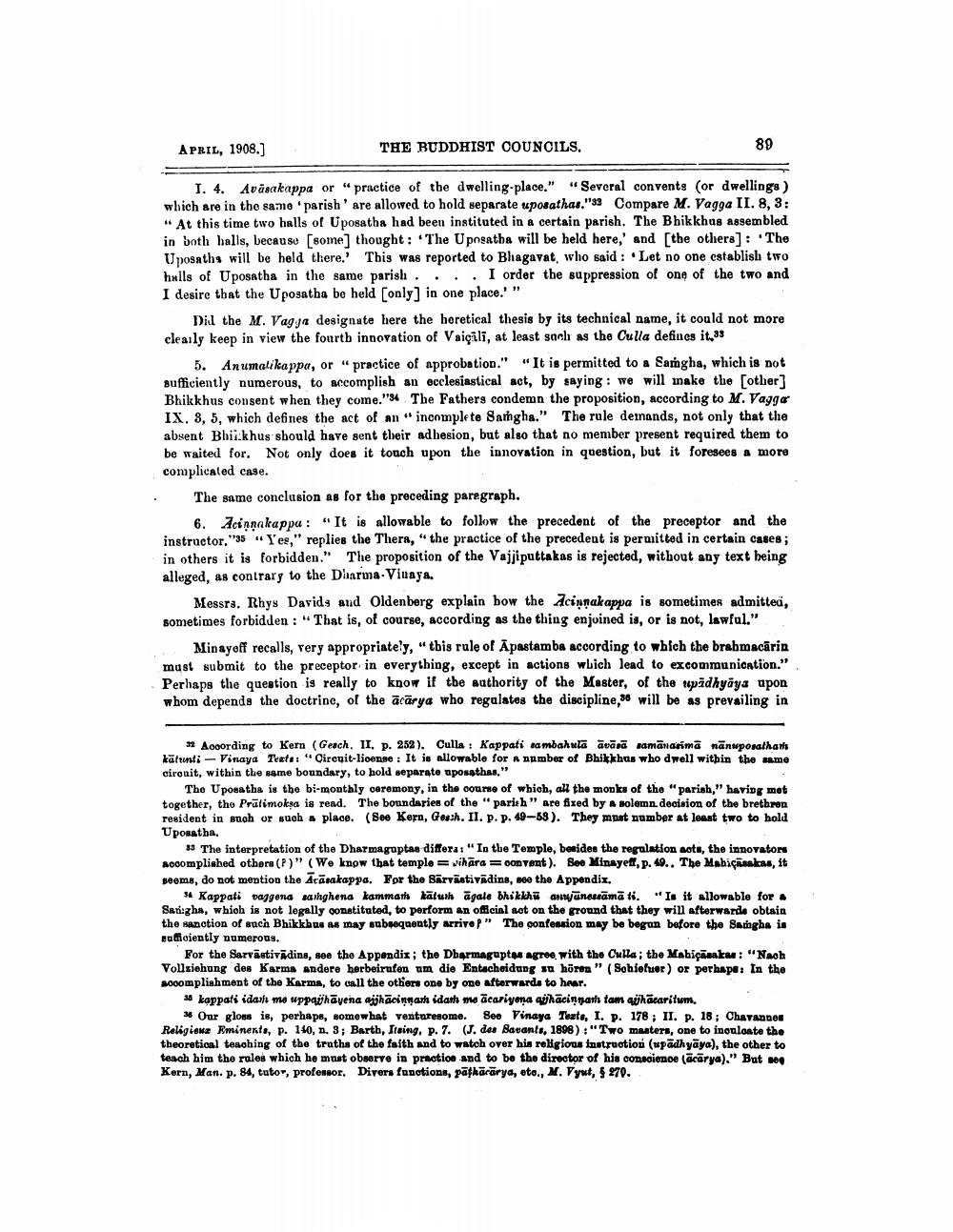________________
APRIL, 1908.)
THE BUDDHIST COUNCILS.
89
1. 4. Aväsakappa or “practice of the dwelling-place." "Several convents (or dwellings) which are in the same "parish' are allowed to hold separate uposathas."92 Compare M. Vagga II. 8, 3: "At this time two halls of U posatba had been instituted in a certain parish. The Bhikkhus assembled in both halls, because some thought : "The Uposatba will be held here,' and [the others] : The U posaths will be held there. This was reported to Bhagavat, who said : Let no one establish two hulls of Uposatha in the same parish .... I order the suppression of one of the two and I desire that the U posatha be held [only] in one place.' ”.
Did the M. Vagya designate here the horetical thesis by its technical name, it could not more clearly keep in view the fourth innovation of Vaicali, at least sach as the Culla defines it,33
5. Anumalikappa, or practice of approbation." "It is permitted to a Sangha, which is not sufficiently numerous, to accomplish an ecclesiastical act, by saying: we will make the other Bhikkhus consent when they come."4 The Fathers condemn the proposition, according to M. Vagga IX. 8, 5, which defines the act of an incomplete Sangha." The rule deinands, not only that the absent Bhikhus should have sent their adhesion, but also that no member present required them to be waited for. Not only does it touch upon the innovation in question, but it foresees a more complicated case.
The same conclusion as for the preceding paregraph.
6. Acinnakappa: "It is allowable to follow the precedent of the preceptor and the instructor,"35" Yes," replies the Thera, "the practice of the precedent is permitted in certain cases; in others it is forbidden." The proposition of the Vajjiputtakas is rejected, without any text being alleged, as contrary to the Dharma-Vinaya.
Messrs. Rhys Davids and Oldenberg explain bow the Acinnakappa is sometimes admittea, sometimes forbidden: "That is, of course, according as the thing enjoined is, or is not, lawful."
Minayoff recalls, very appropriately, "this rule of Apastamba according to which the brabmacärin must submit to the preceptor in everything, except in actions which lead to excommunication." Perhaps the question is really to know if the authority of the Master, of the spadhyāya upon whom depends the doctrine, of the acārya who regulates the discipline, 50 will be as prevailing in
52 According to Kern (Geach. II, p. 252). Culla : Kappati sambahuta avārā samānainimā nānuposathar kātunti - Vinaya Teata: "Circuit-license : It is allowable for Animber of Bhikkhus who dwell within the same cironit, within the same boundary, to bold separate aposathas."
The Upon the is the bi-monthly ceremony, in the course of which, all the monks of the "parish," having met together, the Prātimoksa is read. The boundaries of the "parish" are fixed by A solemn decision of the brethren resident in anoh or sugh place. (Boo Kern, Gesch. II. p. p. 49-58). They must number at least two to hold Upobatha.
38 The interpretation of the Dharmagaptas differa: "In the Temple, besides the regulation acts, the innovators accomplished others (?)" (We know that temple = vihara = convent). See Minayett, p. 49.. The Mabicāsakas, it neeme, do not mention the Arāsakappa. For the Barvästivādins, nee the Appendix.
Kappati baggena sathghena kamman kātush āgale bhikkhi anwünsstāmā ti. "Is it allowable for Sar:gha, which is not legally constituted, to perform an official act on the ground that they will afterwards obtain the sanction of such Bhikkhas as may subsequently arrive" The confession may be began before the Sangha is officiently numerous.
For the Sarvästivādins, see the Appendix; the Dharmagupt agree with the Culla; the Mabicāsaka: "Nach Vollziehung des Karms andere herbeirufen um die Entscheidung su hören" (Sobieluer) or perhape: In the sooomplishment of the Karma, to call the others one by one afterwards to hear.
18 kappati idarf me wppachāyena ajjhācinnan idath me ācariyena qihācingan tam ühācaritum.
26 Our gloss is, perhape, somewhat venturesome. See Vinaya Thats, I. p. 178; II. p. 18; Chavannes Religione Eminents, p. 140, n. 3; Barth, Itsing. p. 7. (J. des Savants, 1898): "Two masters, one to inonloate the theoretical teaching of the traths of the faith and to watch over his religious instruction (upadhyāya), the other to teach him the rules which he must observe in praction and to be the director of his conscience (acarya)." But see Kern, Man. p. 84, tuto, professor, Divers fanctions, pathācārya, eto., M. Vyut, $ 270.




